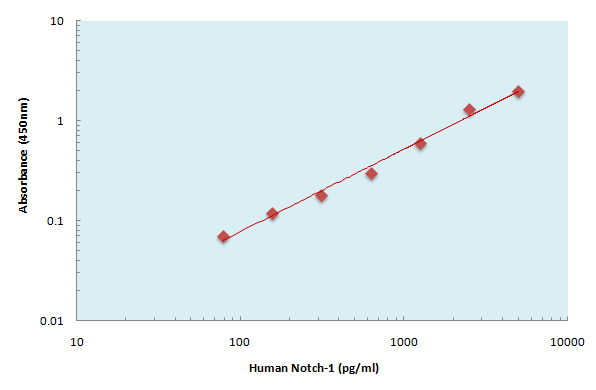Human Notch-1 ELISA Kit
- Catalog No.:KE1156
- Applications:ELISA
- Reactivity:Human
- Gene Name:
- NOTCH1
- Protein Name:
- Neurogenic locus notch homolog protein 1
- Human Gene Id:
- 4851
- Human Swiss Prot No:
- P46531
- Mouse Swiss Prot No:
- Q01705
- Specificity:
- Sample Type for Cell Culture Supernates, Cell lysates, Tissue Lysates, Serum, EDTA Plasma, Heparin Plasma
- Storage Stability:
- 2-8°C/6 months
- Other Name:
- NOTCH1;TAN1;Neurogenic locus notch homolog protein 1;Notch 1;hN1;Translocation-associated notch protein TAN-1
- Detection Method:
- Colorimetric
- Background:
- disease:Defects in NOTCH1 are a cause of aortic valve disease [MIM:109730]. The disorder consists of an early developmental defect in the aortic valve and a later de-repression of calcium deposition that causes progressive aortic valve disease. Calcification of the aortic valve is the third leading cause of heart disease in adults. The incidence increases with age, and it is often associated with a bicuspid aortic valve present in 1-2% of the population.,disease:NOTCH1 truncation is associated with T-cell acute lymphoblastic leukemia.,function:Functions as a receptor for membrane-bound ligands Jagged1, Jagged2 and Delta1 to regulate cell-fate determination. Upon ligand activation through the released notch intracellular domain (NICD) it forms a transcriptional activator complex with RBP-J kappa and activates genes of the enhancer of split locus. Affects the implementation of differentiation, proliferation and apoptotic programs. May be important for normal lymphocyte function. In altered form, may contribute to transformation or progression in some T-cell neoplasms. Involved in the maturation of both CD4+ and CD8+ cells in the thymus. May be important for follicular differentiation and possibly cell fate selection within the follicle. During cerebellar development, may function as a receptor for neuronal DNER and may be involved in the differentiation of Bergmann glia.,PTM:Phosphorylated.,PTM:Synthesized in the endoplasmic reticulum as an inactive form which is proteolytically cleaved by a furin-like convertase in the trans-Golgi network before it reaches the plasma membrane to yield an active, ligand-accessible form. Cleavage results in a C-terminal fragment N(TM) and a N-terminal fragment N(EC). Following ligand binding, it is cleaved by TNF-alpha converting enzyme (TACE) to yield a membrane-associated intermediate fragment called notch extracellular truncation (NEXT). This fragment is then cleaved by presenilin dependent gamma-secretase to release a notch-derived peptide containing the intracellular domain (NICD) from the membrane.,similarity:Belongs to the NOTCH family.,similarity:Contains 3 LNR (Lin/Notch) repeats.,similarity:Contains 36 EGF-like domains.,similarity:Contains 5 ANK repeats.,subcellular location:Following proteolytical processing NICD is translocated to the nucleus.,subunit:Heterodimer of a C-terminal fragment N(TM) and an N-terminal fragment N(EC) which are probably linked by disulfide bonds. Interacts with DNER, DTX1, DTX2 and RBPSUH. Also interacts with MAML1, MAML2 and MAML3 which act as transcriptional coactivators for NOTCH1.,tissue specificity:In fetal tissues most abundant in spleen, brain stem and lung. Also present in most adult tissues where it is found mainly in lymphoid tissues.,
- Function:
- cell morphogenesis, cell morphogenesis involved in differentiation, angiogenesis, blood vessel development, cell fate specification, morphogenesis of a branching structure, epithelial to mesenchymal transition, liver development, hair follicle development, vasculature development, sprouting angiogenesis, regionalization, transcription, regulation of transcription, DNA-dependent, regulation of transcription from RNA polymerase II promoter, immune response, cell surface receptor linked signal transduction, Notch signaling pathway, positive regulation of transcription of Notch receptor target, gamete generation, spermatogenesis, determination of left/right symmetry, compartment specification, pattern specification process, ectoderm development, axonogenesis, ectodermal gut development,foregut morphogenesis, endoderm development, heart development, positive regulation of cell proliferation,
- Subcellular Location:
- Cell membrane ; Single-pass type I membrane protein .; [Notch 1 intracellular domain]: Nucleus . Following proteolytical processing NICD is translocated to the nucleus. Nuclear location may require MEGF10. .
- Expression:
- In fetal tissues most abundant in spleen, brain stem and lung. Also present in most adult tissues where it is found mainly in lymphoid tissues.
- June 19-2018
- WESTERN IMMUNOBLOTTING PROTOCOL
- June 19-2018
- IMMUNOHISTOCHEMISTRY-PARAFFIN PROTOCOL
- June 19-2018
- IMMUNOFLUORESCENCE PROTOCOL
- September 08-2020
- FLOW-CYTOMEYRT-PROTOCOL
- May 20-2022
- Cell-Based ELISA│解您多样本WB检测之困扰
- July 13-2018
- CELL-BASED-ELISA-PROTOCOL-FOR-ACETYL-PROTEIN
- July 13-2018
- CELL-BASED-ELISA-PROTOCOL-FOR-PHOSPHO-PROTEIN
- July 13-2018
- Antibody-FAQs
- Products Images

- The Human Notch-1 ELISA Kit allows for the detection and quantification of endogenous levels of natural and/or recombinant Human Notch-1 proteins within the range of 79-5000 pg/ml.



